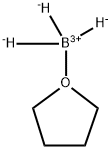Purification Methods
It is available as the solid dimer or in tetrahydrofuran solution. The solid is relatively stable and can be purified by distillation in a vacuum (as dimer) and by recrystallisation from tetrahydrofuran (solubility at room temperature is 9.5%, 0.78M), filter off the solid under N2, wash it with dry pentane and dry it in vacuo at ca 100o. The solid is a dimer (IR 1567cm-1), stable in air (for ca 2 months), and can be heated for 24hours at 200o in an inert atmosphere without loss of hydride activity. It is a dimer in tetrahydrofuran solution also (IR 1567cm-1). It is sensitive to H2O and air (O2) in solution. Its concentration in solution can be determined by reaction with MeOH and measuring the volume of H2 liberated, or it can be oxidised to cis-cyclooctane-1,5-diol (m 73.5-74.5o). [IR: Knights & Brown J Am Chem Soc 90 5280 1968, Brown et al. J Am Chem Soc 96 7765 1974, Brown et al. J Org Chem 41 1778 1976, Brown & Chen J Org Chem 46 3978 1981, Fieser & Fieser Reagents for Org Synth 2 31, 3 24, 10 48, 15 43, 17, 49.] Borane pyridine complex [110 -51 -0] M 92.9, m 8-10o, 10-11o, b 86o/7mm, 100-1 0 1o/12mm, d 4 0.785. Dissolve it in Et2O and wash it with H2O in which it is insoluble. Evaporate the Et2O and distil the residual oil to gives better than 99.8% purity. Its vapour pressure is less than 0.1mm at room temperature. [Taylor et al. J Am Chem Soc 77 1506 1955, Beilstein 20 IV 2235.]




